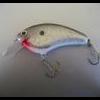I have a couple of friends who grew up fishing spinning rods but eventually wanted to get into baitcasting. Two things figured into them becoming successful. First, you need to start with a good reel and you get what you pay for. Modern reels have better controls, are built to better tolerances, and they just work smoother with fewer backlashes. I've been throwing a baitcaster for 25 years now and wouldn't dream using an Abu 5500 for anything but striper trolling! The other thing is learning how to cast a baitcaster, and that is quite different. With a spinning reel, the line is coming off the spool in good order no matter what crazy casting motion you use or how hard you swing it. But a baitcaster requires a smooth, controlled casting motion. Every time. When you develop one, you can dial down most of the cast control and brakes and get surprisingly long and accurate casts with not much effort. When you are first learning, the tendency is to apply way too much cast control and brake. Don't want to risk a frustrating backlash, right? Then to get reasonable casting distance, you try to overpower the cast and voila - a giant backlash.





